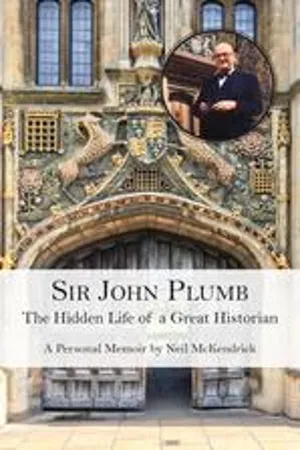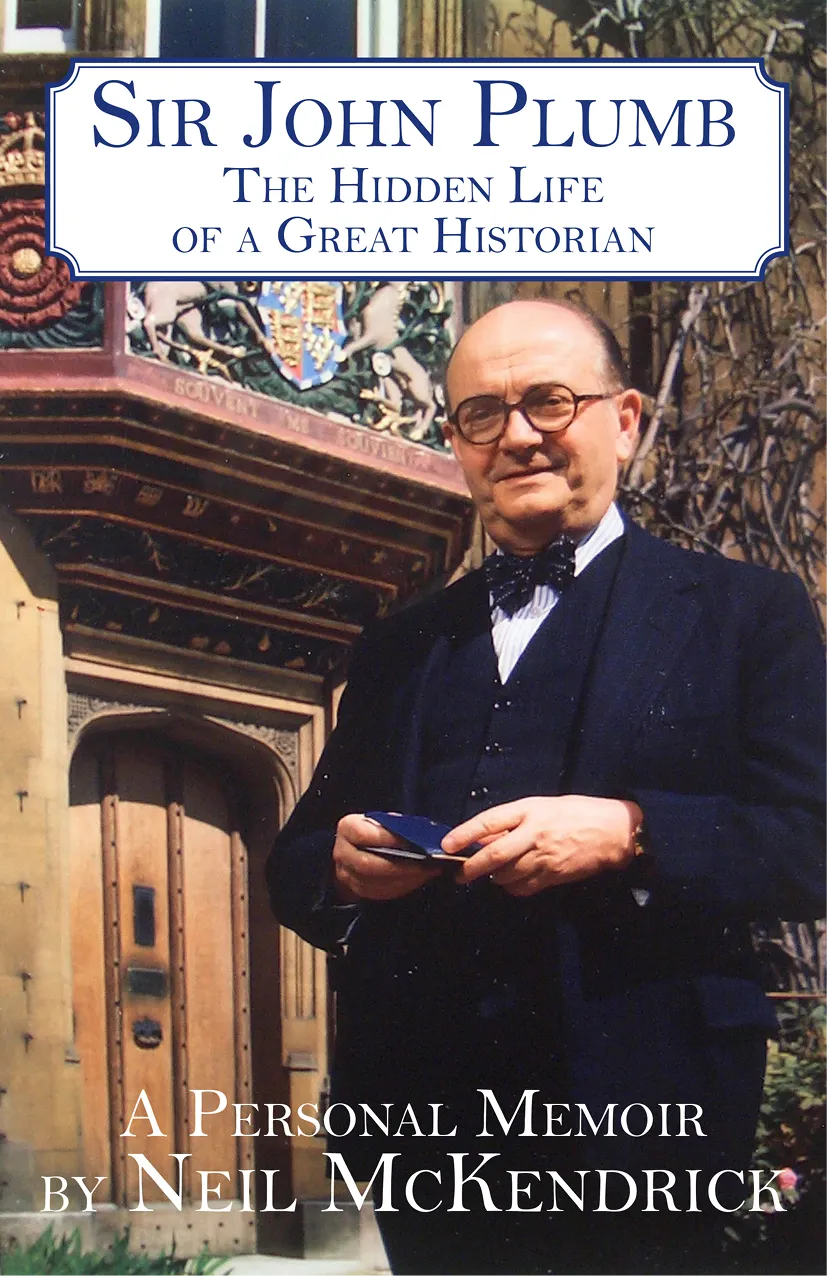
- 298 pages
- English
- ePUB (mobile friendly)
- Available on iOS & Android
About this book
Sir John(Jack)Harold Plumb(1911 – 2001) was a great British historian. He led an extraordinary lifeof startling contrasts, much of it cloaked in secrecy. This memoir attempts to lift that cloak. / This is a very personal account written by Neil McKendrick, a fellow historian, a fellow Master of a Cambridge college and one his oldest and closest friends, who knew Plumb from his early days to his dying hours some fifty years after they first met. / This new memoir depicts a startlingly revelatory portrait of a complex and controversial man who moved from poverty to great affluence; from beginning his life in a two-up two-down terrace house in Leicester to end it in what was called "Jack's Palace" surrounded by a world-class collection of Vincennes and Sèvres. / Plumb's personality was sufficiently beguiling to attract the attention of four significant novelists who left six vivid if unflattering fictional versions of him – depicting him as a ruthless charmer, a serial bisexual philanderer and, most bizarrely of all, as a murderer planning a further murder. In truth the real man needed no fictional elaboration to make him unusually interesting. In fact, his life is often astonishing. The historian, who achieved such international eminence that, on the direct order of the US President and after a unanimous vote in Congress, the Union flag was flown over the American Congress on his 80thbirthday to do honour to the historian who had taught the American people so much, was no run of the mill academic. / In addition to his academic work, during theSecond World WarPlumb worked in the code-breaking department of theForeign OfficeatBletchley Park, Hut 8&Hut 4; later Block B. He headed a section working on a German Naval hand cipher, Reservehandverfahren.He became Professor of Modern English History at Cambridge in 1966, serving as Master of Christ's College from 1978-82, when he was knighted in 1982.His pupils included Simon Schama, Roy Porter, Niall Ferguson and Quentin Skinner. / Plumb had moved from drinking beer in down-market pubs in his youth to drinking champagne in aristocratic drawing rooms and owning the finest collection of claret in Cambridge; from a passionate socialist for most of his life (with, at one time, strong Communist sympathies) to a passionate Thatcherite in his 70s; from his provincial working class family in Leicester to become a close friend of the Rothschilds and a companion of the Queen's sister who gave a memorable 80thbirthday party for him in her home at Kensington Palace Gardens. / He moved from a Cambridge college reject in his youth to the Mastership of Christ's; from a rejected author (of both a novel and his early research) to an acclaimed and prolific writer, editor and journalist; from a conventional heterosexual youth in Leicester to an opportunistic bisexual life thereafter; from his life-enhancing and inspiring best to his embittered worst in extreme old age; from his infancy when he was wet-nursed by a friend of his mother's to his funeral when he was buried without mourners or music or elegies or even a coffin. For all his achievements, his life also encompassed failure and disappointments and its end was almost unbearably sad. / This memoir is an attempt to do for Plumb what a relative of Lord Macaulay once did for that great historian, when he wrote: "There must be tens of thousands whose interest in history and literature he has awakened and informed by his pen, and who would gladly know what manner of man it was that has done them so great a service". The "manner of man" that emerges from this book is as fascinating as it is surprising./ Contents: Introduction. Biography. Preface. Sir John Plumb. Family upbringing and schooling: Leicester and Alderman Newton's. Plumb at Cambridge. Plumb's Early Research. Plumb's publications. Plumb, Elton and Chadwick and The Regius Chair. Plumb and his adopted family. Plumb's Reputation as a Patron, a Promoter and a Fixer. Fictional Portraits of Plumb. Painted Portraits of Plumb. Plumb at Bletchley. Influences on Plumb. The Sources of Plumb's wealth. Plumb as Editor. Plumb's Apolarist Life style. Expensive cars and Their Destruction. Plumb the Big Spender: Houses, Holidays and Other Indulgences. Plumb and His New friends: A Case of Social Nobility. Plumb's reputation as a Scholar. Plumbs' Health and His Declining Productivity. Plumb's Professional Reputation. Plumbs' Dedications. Plumbs' Other Writing. Plumb's Pupils. Plumb's Changing Political Beliefs. Plumb's Generosity: to his Staff and His Friends and Himself. Plumb's Wine. Plumb's Donations. Plumb's Private Life. Plumb and Friendship. The Posthumous Sale of 2002. Plumb's Adopted Family. A Postscript on the Black Years. The Plumb Master ship in Context. Other Public Recognition. Desert Island Discs. Plumb's Changing Attitudes' to His Pupils. The End of Life, Death and a Memorial Dinner: Memories and Legacy and Final Judgements. Postscript: Sir J.H.Plumb Historian and Teacher of Historians. Acknowledgements. Select Bibliography.
Frequently asked questions
- Essential is ideal for learners and professionals who enjoy exploring a wide range of subjects. Access the Essential Library with 800,000+ trusted titles and best-sellers across business, personal growth, and the humanities. Includes unlimited reading time and Standard Read Aloud voice.
- Complete: Perfect for advanced learners and researchers needing full, unrestricted access. Unlock 1.4M+ books across hundreds of subjects, including academic and specialized titles. The Complete Plan also includes advanced features like Premium Read Aloud and Research Assistant.
Please note we cannot support devices running on iOS 13 and Android 7 or earlier. Learn more about using the app.
Information

- Introduction
- J.H.Plumb’s Curriculum Vitae
- Preface: Jack Plumb: A Personal Memoir from 1949 to 2001
- Plumb in Leicester: Family Upbringing and Schooling
- Plumb’s Coming to terms with Cambridge
- Plumb’s Early Research and his later Publications
- Plumb, Elton and Chadwick and the Regius Chair
- Plumb the Possessive Father Figure
- Plumb’s Reputation as Patron, Promoter and Fixer
- Plumb in Fiction
- Plumb’s Painted Portraits
- Plumb and the Secret World at Bletchley Park
- Plumb: his tastes, his collections and his enthusiasms
- Plumb’s wealth – Its Sources and its Size
- Plumb as a prolific Editor
- Plumb’s American Journalism – American Heritage and Horizon
- Plumb’s Apolaustic Lifestyle: Expensive Cars and their Destruction
- Plumb the Big Spender: Houses, Holidays and other Indulgences
- Plumb and his New Friends: A Case of Social Mobility
- Plumb’s Reputation as a Scholar and Walpole III
- Plumb’s Health and his Declining Productivity
- Plumb’s Critique of Cambridge Historians
- Plumb’s Dedications
- Plumb’s Other Writing
- Plumb’s Other Pupils and Plumb the Novelist Manqué
- Plumb’s Changing Political Beliefs and the Blunt Affair: from Communist Sympathiser to Combative Tory
- Plumb’s Generosity to his Staff, his Friends and Himself
- Plumb and his Wine
- Plumb and Philanthropy
- Plumb’s Very Private Love Life: Sex, Secrets and Subterfuge
- Plumb and Friendship
- Plumb’s Posthumous Sale in 2002
- Plumb’s Secret Daughter and his Attitude to Marriage and Children
- Plumb’s 90th Birthday: a Symbol of Old Age and the Black Years
- Plumb and his Mastership of Christ’s in Context
- Plumb and Public Recognition: the film If and Desert Island Discs
- Plumb’s Changing Attitude to his Pupils
- Plumb: the End of Life, his Death, his Burial and a Memorial Dinner
- Plumb and his Legacy: Historian and Teacher of Historians
- Acknowledgements
Table of contents
- Plumb eBook